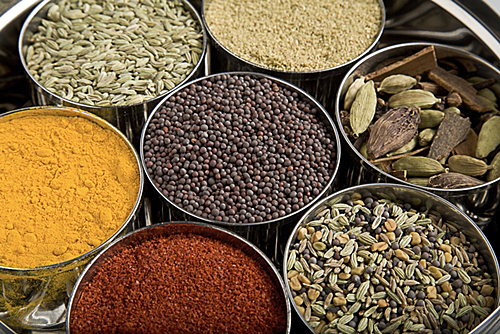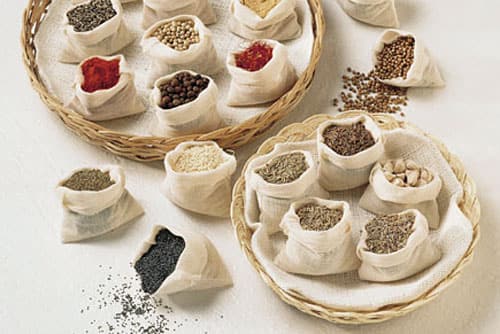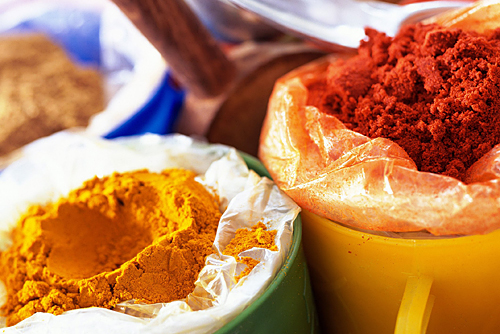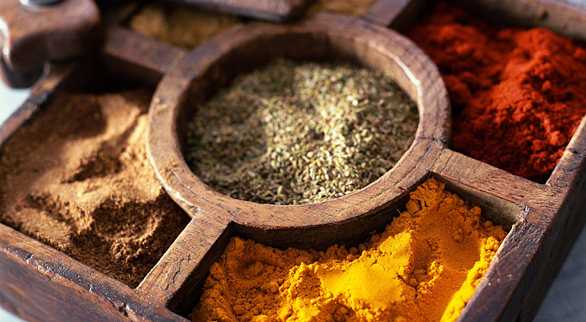Seasonings bring out the flavors in food and add complementary tastes, all to enhance the eating experience.
Salt & Pepper
The two most fundamental and widely used spices are salt and pepper. Typically what people think of when speaking of salt and pepper is white, granulated salt and pre-ground black pepper. But these are far from the only kinds of salt and pepper that exist.
Rock salt is a great salt variation, with larger crystals for a bigger punch. Sea salt is cherished by many as a more natural culinary salt. There's also Kosher, iodized, pickling and black salt, among others.

The assortment of peppers to explore is at least as vast, with chili pepper, jalapeno pepper, habanero pepper, cayenne pepper and innumerable others, even white pepper, each with its own degree of spiciness and its own subtle flavor distinctions.
It's not uncommon to serve dishes unseasoned with a shaker of salt and a grinder full of peppercorns on hand. Pepper may be sold in flakes or ground into a powder. Salt, with the exception of rock salt, is usually granulated.
Herbs & Spices
Most individual seasonings (we'll get to blends in a minute) are classified as either herbs or spices.
- Herbs are usually the fresh or dried leaves of succulent plants that tend to grow in particularly temperate climates.
- Spices generally refer to any seasoning made from the other parts of the plant besides the leaves, including the roots, stems, bark, seeds, fruit or buds.
That said, these descriptions are not definitive, as chefs everywhere will use the two terms differently. Often, the term spices will be used to describe all seasonings, including herbs.

Herbs tend to have a milder flavor, while spices tend to be more pronounced. Common cooking herbs include basil, oregano, marjoram, parsley, rosemary, thyme and dill. Common culinary spices include cinnamon, paprika (another pepper), tumeric, ginger, saffron and cumin. Ginger and garlic are both considered spices as well.
Certain herbs and spices come from different parts of the same plant, such as dill seed and dill weed. Two other herbs, cilantro and coriander, both come from the same plant, but at two different stages in its growth cycle.

Many herbs and spices come from different varieties of the same plant, such as the mind-boggling array of types of basil, including Thai basil, Lemon basil, Cinnamon basil and Royal basil. What's more, basil is just one kind of mint, of which there's an even greater variety.
Still other herbs and spices, like licorice, fennel and star anise, merely have a similar flavor that only makes them seem related, even though they're not. Herbs and spices may be sold whole or ground.
Seasoning Blends
There are also a near endless array of seasoning blends on the market, many of which are based on the unique culinary traditions of various cultures and ethnicities.
Examples of some of these ethnic seasoning blends (as they're sometimes called) are Cajun, Creole, and Italian. Other seasoning blends will be designed to complement specific types of food, such as a fish or poultry seasoning blend, steak seasoning or a grilling blend.

Seasoning blends may be dry or wet. Dry blends contain only herbs and spices mixed together. Among the simplest and most common of dry blends are garlic salt and onion salt mixtures.
Wet blends include some sort of liquid, often a kind of vinegar or oil, or both. Ketchup and mustard are two of the most prevalent wet seasonings. Others include Tabasco sauce, soy sauce and Worcestershire sauce.
A common Indian spice blend is curry, erroneously believed to be an individual spice from the curry plant. Curry comes in a number of dry blends, including red curry, yellow curry and green curry, as well as a liquid curry paste.
